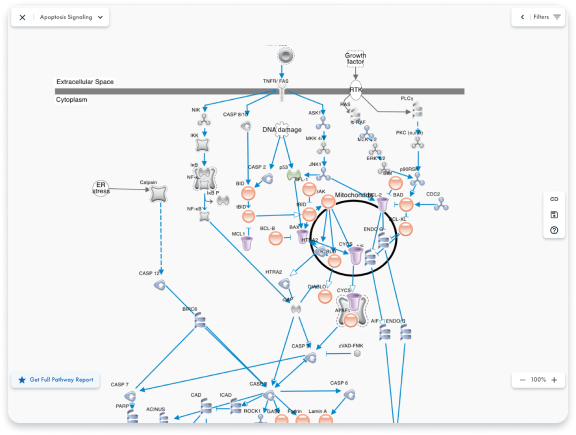Pathways Knowledge Library
Over 400 well-characterized and interactive metabolic and
cell signaling pathways

Browse canonical pathways by category
Cellular Activity, Metabolism and Homeostasis
Disease
General Signal Transduction
Cell Junction and Cytoskeleton-related signaling7 Pathways Growth Factor Signaling21 Pathways JAK-STAT signaling7 Pathways Lipid-based signaling3 Pathways MAPK signaling3 Pathways Nucleotide-based signaling17 Pathways p70s6K Signaling2 Pathways PI3K/AKT/mTOR signaling3 Pathways TNF signaling4 Pathways Other signal transduction pathways11 Pathways
Immunology & Inflammation
Neurology
Organism Physiology
Angiogenesis2 Pathways Cardiovascular Biology8 Pathways Coagulation4 Pathways Gastrointestinal Biology2 Pathways Hematopoiesis5 Pathways Hormonal Signaling7 Pathways Kidney Biology2 Pathways Melanocyte Biology4 Pathways Musculoskeletal & Nervous System Biology8 Pathways Organism Metabolism & Homeostasis18 Pathways Reproductive Biology4 Pathways
Stem Cells & Development
FAQ
What third-party library prep kits can I use?
Another RAP important Q&A
Another RAP important Q&A
Another RAP important Q&A
SEO Description
Apoptosis is a coordinated, energy-dependent process that involves the activation of a group of cysteine proteases called caspases and a cascade of events that link the initiating stimuli to programmed cell death. Caspases in apoptosis are broadly divided into initiators (caspases 2, 8, 9 and 10) and executioners (caspases 3, 6 and 7). The two main pathways of apoptosis are the intrinsic and extrinsic pathways. Each pathway requires specific triggers to initiate a cascade of molecular events that converge at the stage of caspase 3 activation. The activation of caspase 3 in turn triggers an execution pathway resulting in characteristic cytomorphological features including cell shrinkage, membrane blebbing, chromatin condensation and DNA fragmentation.
The intrinsic signaling pathways that initiate apoptosis involve non-receptor-mediated intracellular signals (e.g. DNA damage, radiation) that cause changes in the inner mitochondrial membrane. The end result is a change in mitochondrial transmembrane potential and release of two main groups of pro-apoptotic proteins from the intermembrane space into the cytosol. The first group consists of cytochrome c (CYTC), SMAC/DIABLO, and the serine protease high temperature requirement protein A2 (HTRA2/OMI). These proteins activate the caspase-dependent mitochondrial pathway. CYTC binds and activates apoptotic peptidase activating factor 1(APAF-1) as well as procaspase-9, forming an apoptosome leading to caspase-9 activation. SMAC/DIABLO and HTRA2/OMI promote apoptosis by inhibiting IAP (inhibitors of apoptosi




